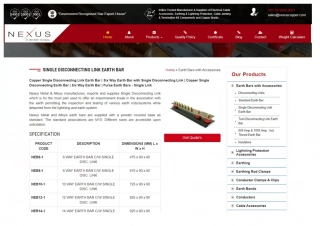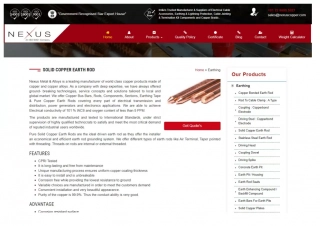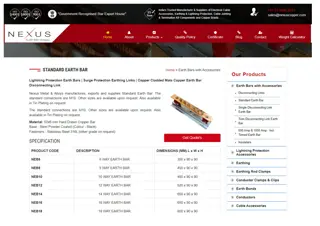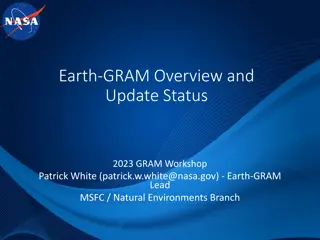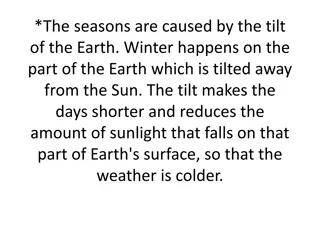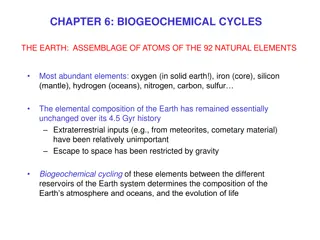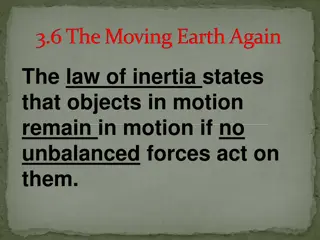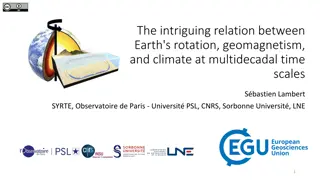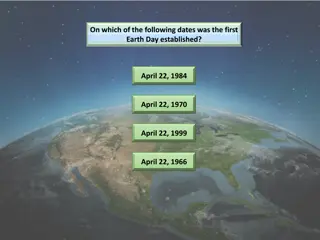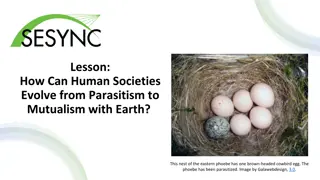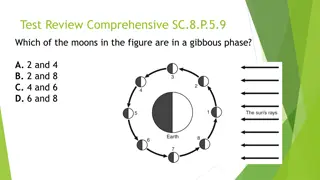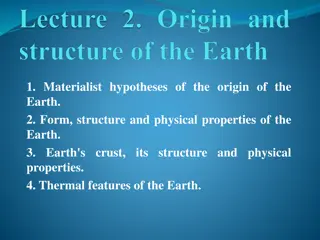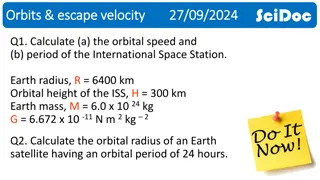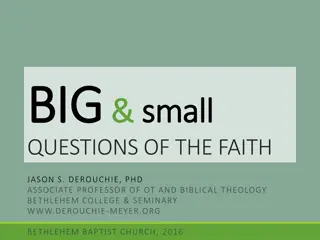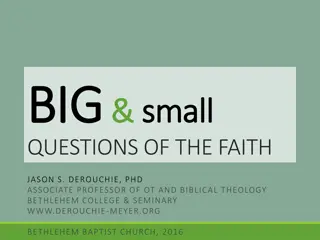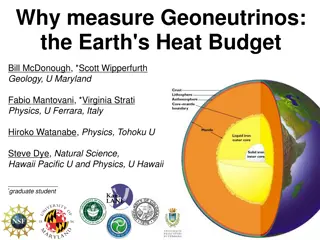EARTH Study
This study, conducted by Michael Kitto and the National Center for Healthy Housing, focuses on assessing radon testing in housing, specifically looking at standards and protocols for multifamily buildings. The research project aims to collect data on radon levels in residential units through ground floor testing to ensure safety and compliance with regulations.
Download Presentation

Please find below an Image/Link to download the presentation.
The content on the website is provided AS IS for your information and personal use only. It may not be sold, licensed, or shared on other websites without obtaining consent from the author.If you encounter any issues during the download, it is possible that the publisher has removed the file from their server.
You are allowed to download the files provided on this website for personal or commercial use, subject to the condition that they are used lawfully. All files are the property of their respective owners.
The content on the website is provided AS IS for your information and personal use only. It may not be sold, licensed, or shared on other websites without obtaining consent from the author.
E N D
Presentation Transcript
1 EARTH Study (Evaluating and Assessing Radon Testing in Housing) Michael Kitto, Principal Investigator Calvin Murphy, Field Data Coordinator Jonathan Wilson, Sherry Dixon, David Jacobs, National Center for Healthy Housing Jane Malone, AARST National Policy Director September 9, 2019
September 9, 2019 2 About the EARTH Study Three year HUD funded research project. Looking at Multifamily testing standards and protocols Regulating Authority Radon testing protocol Federal National Mortgage Assoc. (known as Fannie Mae) 10% of ground floor units Federal Home Loan Mortgage Corp. (known as Freddie Mac) 10% of ground floor units U.S. Department of Housing and Urban Development (HUD) 25% of ground floor units ANSI-AARST MAMF Multifamily Buildings 2017 100% of ground floor units NRPP-accredited and some states require 100% of ground-floor units be tested for radon
September 9, 2019 3 Data Requirements Ground Floor testing results for 100% of residential units. Seeking radon results for buildings with 5 to 20+ ground-floor units. Looking for 30 buildings of every size (59 buildings per category). Have much data for 5-6 and 7-8 unit buildings. Accepting data for all categories. Data collection ends in Dec. 2019.
September 9, 2019 4 EARTH Study data- Distribution of buildings (The target is 59 buildings per building size category) GF Units per building Valid GF buildings 5-6 7-8 9-10 11-12 13-14 15-16 17-18 19-20 More than 20 88 99 42 47 20 23 11 10 29
September 9, 2019 5 How many units, that are all below 4 pCi/L, need to be measured so there is confidence that fewer than 5%, 10%, 15%, 20% and 25% of units are over 4 pCi/L? Number of GF units in building (p=25%) 5 6 7 8 9 10 11 12 13 14 15 16 17 18 19 20 21 22 Theoretical calculations based on hypergeometric distribution. (p=20%) 5 5 5 6 6 7 7 7 7 7 8 8 8 8 8 9 9 9 (p=15%) 5 6 6 6 6 7 8 8 9 9 9 9 9 10 10 11 11 11 (p=10%) 5 6 7 8 9 10 10 10 10 10 10 11 12 12 13 14 14 14 (p=5%) 5 6 7 8 9 10 10 11 12 13 14 15 16 17 18 19 19 19 3 4 5 6 6 6 6 6 6 6 6 7 7 7 7 7 7 7
September 9, 2019 6 Percentage of buildings with ground-floor units containing over 4 pCi/L that would not be found when sampling 10%, 25%, 50% or 75% of ground floor units 10% sampled 25% sampled Mean probability 38% 34% 34% 40% 34% 50% sampled 75% sampled # GF units 05-06 07-08 09-10 11-12 13-20 N Mean probability Mean probability Mean probability 35 50 27 27 33 61% 53% 61% 51% 51% 22% 14% 20% 20% 19% 5% 4% 7% 7% 7% Quiz slide
September 9, 2019 7 Percentage of buildings with 5 or 6 ground-floor units containing radon > 4 pCi/L. Fig 2. Six Ground floor units (n=72 buildings) Fig 1. Five Ground floor units (n=16 buildings) 6 1% 5 0% 5 0% 4 0% 4 6% # Positive 3 25% # Positive 3 4% 2 13% 2 14% 1 6% 1 14% 0 61% 0 56% 0% 10% 20% 30% 40% 50% 60% 70% 0% 10% 20% 30% Percent 40% 50% 60% Percent 28/72 buildings have units with radon >4 pCi/L 7/16 buildings have units with radon >4 pCi/L
September 9, 2019 8 Percentage of buildings with 7 or 8 ground-floor units containing radon > 4 pCi/L. Fig 4. Eight Ground floor units (n=67 buildings) Fig 3. Seven Ground floor units (n=32 buildings) 8 10% 7 0% 7 1% 6 3% 6 3% 5 9% 5 4% # Postive # Postive 4 0% 4 4% 3 9% 3 10% 2 9% 2 10% 1 1 7% 16% 0 48% 0 53% 0% 10% 20% 30% Percent 40% 50% 60% 0% 10% 20% 30% Percent 40% 50% 60% 34/67 buildings have units with radon >4 pCi/L 15/32 buildings have units with radon >4 pCi/L
September 9, 2019 9 Percentage of buildings with 10 or 12 ground-floor units containing radon > 4 pCi/L. Fig 8. Twelve Ground floor units (n=32 buildings) Fig 6. Ten Ground floor units (n=30 buildings) 12 10 11 9 10 8 9 7 8 6 # Postive # Postive 7 5 6 5 4 4 3 3 2 2 1 1 0 0 0% 5% 10% 15% 20% 25% 30% 35% 0% 10% 20% 30% 40% 50% Percent Percent As number of ground floor units increases, the probability of having a unit >4 pCi/L increases.
September 9, 2019 10 Conclusions High percentage of multifamily buildings have radon below 4 pCi/L. 5-10% of buildings with at least one unit having radon over 4 pCi/L would not be identified when 75% of the units are measured.
September 9, 2019 11 If you have data and want to participate Email Calvin at mfrnstudy@gmail.com or call 618-204-5545. $2.00 per line for usable data (previously-collected or new). As you plan to conduct future testing of multifamily buildings, contact Calvin to more easily provide data to the study.
September 9, 2019 12 The work that provided the basis for this publication was supported by funding under cooperative agreement # NYHHU0038-17from the U.S. Department of Housing and Urban Development s Office of Lead Hazard Control and Healthy Homes. The substance and findings of the work are dedicated to the public. The author and publisher are solely responsible for the accuracy of the statements and interpretations contained in this presentation. Such interpretations do not necessarily reflect the views of the Government.


